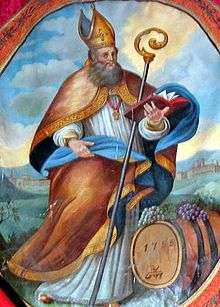Saint Othmar
| Saint Othmar, O.S.B. (or Otmar) | |
|---|---|
 | |
| Born |
c. 689 supposedly near Saint Gallen, Switzerland |
| Died |
c. 759 Werd Island, Lake Constance, Switzerland |
| Venerated in | Eastern Orthodox Church |
| Canonized | 864, Constance, Switzerland by Solomon I, Bishop of Constance |
| Major shrine | Saint Gallen |
| Feast | 16 November |
| Attributes | Crozier and wine barrel |
| Patronage | City of Saint Gall (together with Saint Gallus) |
St. Othmar, O.S.B., (c. 689 – c. 759) was a monk and priest appointed as the first abbot of the Abbey of St. Gall, a Benedictine monastery around which grew up the town of St. Gallen, Switzerland.
Othmar rebuilt the hermitage in which the Irish monk Saint Gall had lived and he is called the founder of the monastery at that site. As part of the Carolingian dynasty's reform movement of Church institutions, he introduced the Benedictine Rule, which was in effect until the secularization and closure of the monastery in 1805. It is also assumed that he founded the monastery school of the abbey, which was to become the foundation upon which the famous Stiftsbibliothek (Monastery library) was built. Abbot Othmar also provided for the needs of the surrounding community, building an almshouse and a hospital, as well as the first leprosarium in Switzerland.
He died in exile on the small island of Werd in Lake Constance due to false accusations by two neighboring nobles. He is buried in St. Gallen, where his body was secretly moved ten years after his death. It is said that his body was still completely intact when he was taken over Lake Constance to the town of Steinach and farther on to St. Gallen. As the weather was very hot when the men rowed his body over the lake, they became extremely thirsty. Legends say that the only barrel of wine they had left did not become empty, regardless of how much they drank. Therefore, the wine barrel became one of his attributes (beside the abbot's crozier).
He was canonized in 864 by Solomon I, Bishop of Constance, and his feast day is celebrated on November 16.[1]